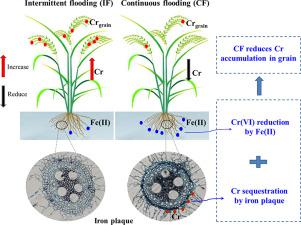Science of the Total Environment ( IF 8.2 ) Pub Date : 2021-05-17 , DOI: 10.1016/j.scitotenv.2021.147786 Wendan Xiao 1 , Xuezhu Ye 1 , Zhiqiang Zhu 2 , Qi Zhang 1 , Shouping Zhao 1 , De Chen 1 , Na Gao 1 , Jing Hu 1

|
Chromium (Cr) contamination in rice poses a serious threat to human health. Therefore, we conducted pot experiments to investigate the influence of water management regimes on the formation of iron plaque on rice roots, and its effect on the accumulation and translocation of Cr in rice grown on contaminated soil. The results showed that water management regimes, including continuous and intermittent flooding, exerted notable effects on soil solution concentrations of Cr(VI) and Cr(III) through changes in redox potential, pH, and dissolved Fe(II) concentrations. In particular, 69.2%–71.8% of Cr(VI) was reduced to Cr(III) under continuous flooding, whereas only 33.3%–38.6% was reduced under intermittent flooding conditions. Additionally, continuous flooding created a rhizosphere environment favorable to the formation of iron plaque. The amount of iron plaque formed increased by 28.2%–47.2% under continuous flooding conditions as compared with that under intermittent flooding conditions. Moreover, compared with intermittent flooding, under continuous flooding, more Cr (18.0%–23.9%) was adsorbed in the iron plaque, thereby sequestering Cr and reducing its mobility. The Cr concentrations in rice root, straw, husk, and grain under continuous flooding conditions were, respectively, 32.0%–36.5%, 32.7%–36.3%, 34.2%–46.9%, and 25.4%–37.7% lower than those under intermittent flooding conditions. Therefore, continuous flooding caused a substantial decrease in the Cr concentrations in rice tissues, as well as an increased distribution of Cr in the iron plaque that acted as a barrier to reduce Cr transfer to the rice roots. These results indicate that continuous flooding irrigation was effective in minimizing the accumulation of Cr in rice plants, as it not only enhanced Cr(VI) reduction in the soil but also improved the blocking capacity of the iron plaque.
中文翻译:

连续淹水会刺激根铁斑的形成,并减少水稻中的铬积累(水稻)。
大米中的铬(Cr)污染对人类健康构成严重威胁。因此,我们进行了盆栽试验,研究了水分管理制度对水稻根系铁斑形成的影响,以及其对受污染土壤中水稻中Cr积累和转运的影响。结果表明,包括连续性和间歇性洪水在内的水管理制度通过改变氧化还原电势,pH值和溶解的Fe(II)浓度,对土壤溶液中的Cr(VI)和Cr(III)浓度产生了显着影响。特别是在连续驱油条件下,Cr(VI)的69.2%–71.8%还原为Cr(III),而在间歇驱油条件下仅还原了33.3%–38.6%。另外,连续驱水创造了有利于铁斑形成的根际环境。与连续驱油条件相比,连续驱油条件下形成的铁斑数量增加了28.2%–47.2%。此外,与间歇驱油相比,在连续驱油下,铁斑块中吸附了更多的铬(18.0%–23.9%),从而螯合了铬并降低了其迁移率。在连续淹水条件下,稻根,稻草,稻壳和谷物中的Cr含量分别比间歇性低32.0%–36.5%,32.7%–36.3%,34.2%–46.9%和25.4%–37.7%。洪水条件。因此,连续淹没导致水稻组织中Cr的浓度大大降低,并且铁斑块中Cr的分布增加,这是减少Cr向水稻根部转移的障碍。











































 京公网安备 11010802027423号
京公网安备 11010802027423号